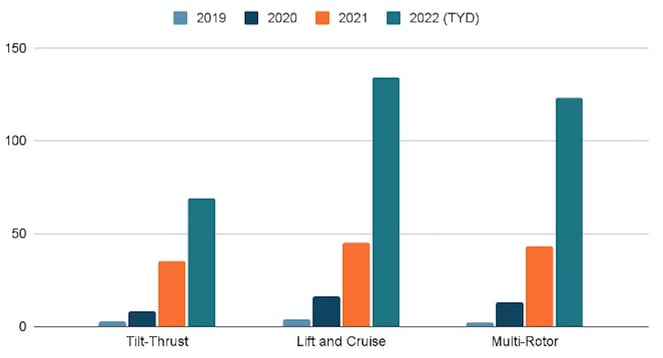When most of us think about smart cities, we think of two key technologies: IoT and EVs. While these are both critical enablers, the story goes much deeper and broader. A wide variety of emerging technologies will be necessary to make the future of urban living into a mainstream experience. Here, we explore three other complementary technology areas that are poised for large-scale innovation thanks to their applications in smart cities.
Urban aviation
Electric vehicles have been an area of expansion for the past decade. In 2021 alone Tesla’s global deliveries reached over 900,000 vehicles. However, the on-the-ground network of roads places an upper limit on the possible flow of transport. To reduce congestion further, smart cities are looking at an alternative: electric vertical take-off and landing aircrafts (See the results in Scout.). eVTOL aircrafts are fully electronically powered and their actions include hovering, taking-off, and landing. Despite the new vehicle’s plane-like actions, they do not need a runway to takeoff or land – and thus can be effective in crowded urban environments where small-volume rider capacity and short travel distances are the norm. Additionally, their main form of charge is through an outlet, similar to electric cars. This type of technology, commonly referred to as urban air mobility, has made a name for itself throughout the construction and infrastructure of smart cities, specifically in Saudi Arabia's NEOM.
NEOM – New Enterprise Operating Model – is intended to be a smart city in the northwestern region of Saudi Arabia. The city, expected to house citizens as soon as Q1 of 2024, is currently under construction and will support a total population of 500,000. NEOM will be an automobile-free city with high speed autonomous electric trains, micro mobility vehicles, as well as eVOTLs which will be responsible for the majority of transit.
Currently, eVTOLs operate in one of three ways, all boasting over 100 patents to date:
- Tilt-Thrust: despite the object’s similar physical appearance to an airplane, the motion of the vehicle follows that of a helicopter; using each individual wing’s rotors the object is moved similar to a helicopter’s propulsion. (See the results in Scout)
- Lift and Cruise: using a fixed motor and several rotors, this form of propulsion mimics that of a helicopter. (See the results in Scout)
-
Multi-Rotor: similar to a drone, the object is remotely controlled and uses rotos to lift and propel the vehicle into motion. (See the results in Scout)

Figure 1: AeVTOL patents, 2019 through October 2022. (Source: Wellspring Scout)
NEOM is collaborating with the German startup Volocopter (See it in Scout) to create eVTOL infrastructure throughout the city. Volocopter’s mission involves a holistic approach to incorporating physical and digital infrastructure into the full ecosystem of multipurpose aircrafts. A 2021 EU research grant (See it in Scout) intends to investigate the possibility of establishing Urban Air Mobility in six different European locations (See the results in Scout).
This advancement in aviation technology will be environmentally friendly, produce a lower amount of noise, and reduce maintenance and infrastructure needs compared to traditional aircrafts. The sustainable technology of smart cities will not only push the commitment to lower pollution forward, but will positively impact existing cities as well. Given their electric nature, small size, and ability to operate without runways, we may have flying cars sooner than we thought.
Desalination
Aviation isn’t the only area of investigation among smart city developers. Given the desert climates that many of these cities plan will be built in, water sources and drinkable water have become vital areas of interest. NEOM continues to be at the forefront of these emerging technologies, especially given the current location in the desert region of the Tabuk province. At the moment, 60% of Saudi Arabia’s water supply stems from desalination – an industrial process that extracts salt from water. The current process uses fossil fuels as its main energy source, and creates brine as a byproduct. Brine is a toxic waste created when seawater is turned to freshwater. The disposal of brine back into the ocean negatively affects the environment through its high salinity – damaging aquatic life as well as creating pollution created by burning fossil fuels.
Several potential solutions to brine’s production and pollution issues focus on powering desalination facilities with renewable energy - including solar, nuclear, or wind power. Brine has numerous potential uses, ranging from acting as a cooling refrigerant to helping with irrigation for salt-tolerable crops. There are hundreds of studies looking to power desalination plants with green energy. Several universities have researched and developed fascinating technologies and methods to address the harmful effects of desalination:
The University of Texas Rio Grande Valley recently created a process to reduce electrical usage and brine production. The humidification-dehumidification desalination (See it in Scout) system is a net-zero system that’s easy to use and reduces overall operating costs while reducing both electrical usage and brine production.
The Qatar Foundation has created licensable technology for turning high-salinity water into potable water using reverse and forward osmosis systems (See it in Scout). The system’s physical tube-like appearance reduces an individual desalination plant’s carbon footprint by 65%. The system utilizes solar energy which reduces a desalination plant's habit of returning used thermal heat to the ocean.
The University of New Mexico has found success reducing desalination toxins using Ion Exchange Technologies (See it in Scout). The method they discovered aims to improve the percentage of recoverable water that desalination plants use. Due to thermal heat transfers and scarce water sources, many plants only return 70-85% of the original water source. The system removes cations using ion exchange technology. This in turn reduces water waste and creates the opportunity to recover specific salts and minerals.
Sustainable buildings
In conjunction with unreliable water sources, desert locations for smart cities face the issue of limited greenery. Utilizing rooftops and building exteriors, the relative presence or absence of plant life can greatly impact energy efficiency. Hundreds of publications have explored the best types of greenery to use for eco-roofs and have found many benefits for reduced energy usage. The investigation of eco-roofs also lends itself to established cities, as studies have found that reusing stormwater reduces energy usage and protects sewer systems from flooding in high-rain areas.
Runoff water quality is another second-hand benefit to rooftop vegetation. Because eco-roofs can process rainwater through their soil, the runoff is usually cleaner and therefore easier to reuse. There are six aspects to eco-roofs: vegetation, growth substrates, filter layers, drainage layers, waterproofing layers, and root barriers. Eco-roofs have been tested in multiple climates from tropical to tundra to deserts. Dry climates returned promisingly low levels of evapotranspiration (See it in Scout), suggesting that rainwater can be a reusable water supply despite the low amount of rainfall.
Zero Energy Buildings (ZEBs) are another area of investigation involving green urban infrastructure (See the results in Scout). These buildings create their own renewable energy onsite, with the goal of generating as much energy as they consume. Renewable energy generation types include hydropower, bioenergy, heat pumps, and solar and wind energy. ZEBs are commonly reduced to several product types in the HVAC line: controls, insulation, glazing, lighting, and water heating. Local sustainable construction also incorporates environmental elements of thermal mass, namely daylight and natural ventilation. Other sustainable technologies include photovoltaic panels, cavity walls, and the practice of double glazing.
Telosa – a United States smart city that is currently rumored to be located in Nevada, Utah, or Texas – could be a prime experiment for ZEB buildings and other forms of sustainable construction. The project has yet to break ground so there is a fair amount of speculation regarding the building methods the city will elect to use. The architecture and city planning behind Telosa stems from BIG – Bjarke Ingels Group (See it in Scout) – an eco-friendly building company headquartered in Denmark. Sidewalk Labs (See it in Scout), an urban innovation and infrastructure subsidiary of Google, is another key collaborator in the effort.
BIG is an active partner in building the first-ever 3D printed neighborhood (See it in Scout), which broke ground in August 2022 outside of Austin, Texas. The neighborhood housing walls will be made of “lavacrete,” a cementitious-based material that is strong enough to withstand severe weather conditions. Using this material in each home’s construction (in combination with photovoltaic solar panels) will make the construction process sustainable and will increase the lifetime of the home. The renewable energy system will benefit homeowners as well as decreasing pollution from construction.
Racing into the future
The list of emerging technologies doesn’t end here. As these cities develop, we will see more advancements in cleantech and pollution-free alternatives. Smart cities are likely to boast hundreds of sustainable advancements to make our current infrastructure more efficient and environmentally sound, including smart systems for water management, waste management, and power management. We have only skimmed the surface of what’s to come and the current technologies are evolving rapidly. While we look to the future for idealistic possibilities, the research and development of these emerging technologies stands to benefit our current urban environments as well.
For more insights like this on other trending markets, check out the entire Data Spotlight series.
Image by Shujon Moral from Pixabay
